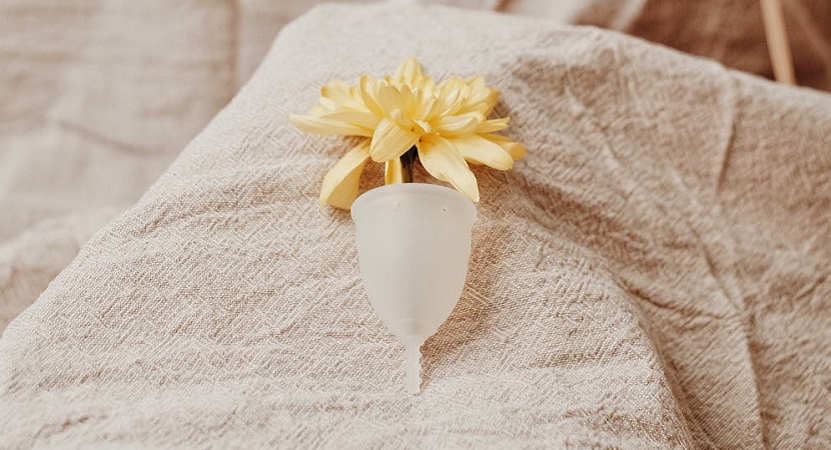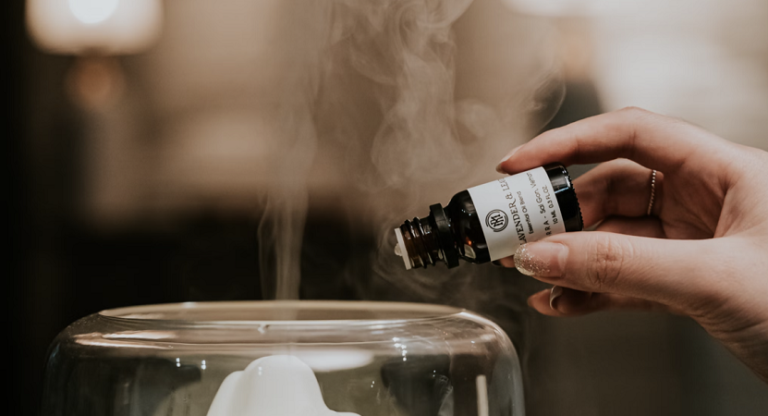As a person who experiences a monthly period, menstrual cups are probably the single best device you’ll ever purchase for yourself. We understand this is quite the bold statement to make, but these nifty companions are saving lives (and the environment) at a rate that’s too impressive to ignore. Read on!
In this article we discuss the following:
- What is a Menstrual Cup?
- Menstrual Cup vs Tampon
- How Does a Menstrual Cup Work?
- Why are Menstrual Cups Good?
- Concerns About Menstrual Cups
- How to Use Menstrual Cup
- Menstrual Cup Quiz
- Disposable Menstrual Cups
- Best Menstrual Cups
- Conclusion
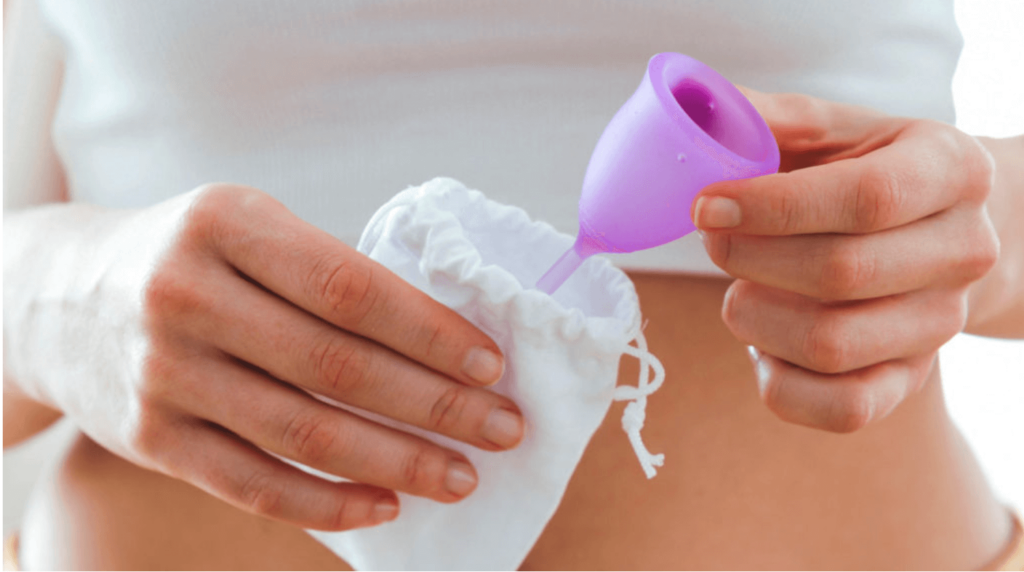
What is a Menstrual Cup?
A menstrual cup, or menstruation cup, is a device used for feminine hygiene during a person’s period cycle. The cup is inserted directly into the vagina during menstruation and acts as a catchment device for the blood.
Most menstrual cups are made from a medical grade substance including silicone, a thermoplastic isomer, or even latex. They are soft yet firm, flexible, and shaped similarly to a spinning top that you grew up playing with as a child — only these are hollow!
A menstrual cup replaces the need for tampons and pads and, as a result, it is sometimes fondly referred to as a tampon cup. You may consider using your menstrual cup along with period panties if you require leak protection.
“Menstrual cups will change your relationship with your period. You will go from dreading it to embracing it,” says Corritta from My Eco Flow.
Menstrual Cup vs Tampon
There is no contest when comparing period cups to tampons. The former outshines the latter every time.
Tampons contribute significantly to the contamination of both the planet, and the human body.
The average person will dispose of 15,000 tampons in their lifetimes, polluting landfills and oceans in the process. Achintya Kolipakkam from Elegance Tips adds that, “a single woman can generate up to 125 kg of non-biodegradable menstrual waste, which takes around 500-800 years to decompose. A state alone can generate 63 million tonnes per year.”
What’s more, tampons have repeatedly proven to be a danger to the human body, with Toxic Shock Syndrome causing fatalities, and cervical cancer as a result of dioxin (the bleach that makes tampons white).
“I’m certainly in favor of menstrual cups since they can hold more blood than other solutions, they can be worn longer, and they’re better for the environment,” says Dr. Lina Velikova, MD, Ph.D., medical advisor at Supplements101.
A menstrual cup is not a disposable device. They are reusable, and only need to be replaced once every few years. The cups are not compostable, but they are all made free from hazardous waste material, which means they are totally recyclable after a lifetime of use.
“Silicone cups don’t leach toxic chemicals like bleached cotton found in tampons. In addition, a cup can last for years, saving a huge amount of energy, water, and pesticides that would go into producing cotton for tampons,” says Dr. Samantha Radford from Evidence-based Mommy.
From a spending point of view, your menstrual cup is a one off expense compared to tampons/pads that are a monthly one. It’s really a no brainer.
How Does a Menstrual Cup Work?
So, how do menstrual cups work, anyway? Menstrual cups work by settling themselves perfectly into the vaginal canal, creating a seal between the rim of the cup and the walls. You insert the cup the same way you would a tampon without an applicator; there is a slight technique to it, which we will discuss in detail later on.
Instead of absorbing blood like a tampon or pad, a menstrual cup simply catches it. The seal between the cup and the vaginal walls is vacuum tight, so there is virtually no way for the blood to go anywhere other than the empty space within the device.
You can generally sense when your menstrual cup is ready to be emptied; it’s a difficult sensation to describe, as most active users will tell you. For some this is every few hours, but for most it will go 12 hours leak-free.
“Imagine a life where you can go 12 hours without having to think about your pad or tampon, and a life where you don’t leak or feel uncomfortable during your period,” says Kim Rosas of Period Nirvana.
Menstrual Cup Diagram
If you’re pondering how do period cups work in that seemingly confined space down below, this diagram will help you visualize it:
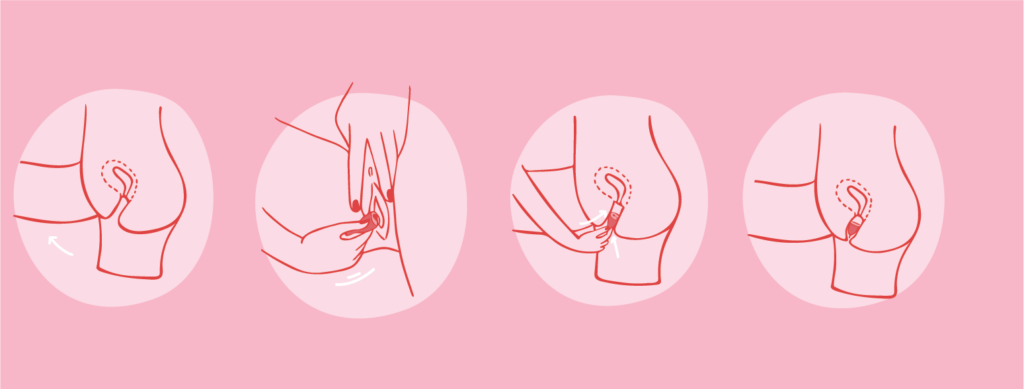
Why are Menstrual Cups Good?
One of the main reasons why menstrual cups are so good is because of their direct competition against disposable feminine hygiene products such as tampons and pads. We looked at the specifics of this earlier, but we’d like to throw a few more benefits into the mix for good measure.
Firstly, menstrual cups actually accelerate life, instead of inhibiting it. You can run, swim, sleep, and dance without ever needing to worry about bleeding out due to the vigorous movement. This is not something we’ve found to be universally true with any other feminine hygiene devices.
“I love menstrual cups because I can take one with me all over the world and not have to stress about the availability, cost or waste associated with tampons or pads,” says Jackie O., Sustainable Travel and Lifestyle Entrepreneur.
More importantly, menstrual cups don’t dry out the vagina, which means less bacterial infections prior to use. Tampons pull all moisture from their surrounding environment, including the good lubrication that works to protect you from bacterial imbalance: the result being frequent yeast infections, uncontrollable discharge, or foul smelling odors.
Concerns About Menstrual Cups
Are Menstrual Cups Safe?
So long as you use your reusable menstrual cup as directed, you’re at very little risk of ever experiencing one of the few side effects associated with these devices.
These cups are safe for use by all individuals who experience a monthly period. Since they are medical-grade devices, there is a sanitary expectation for all users to adhere to. The intimate nature of the cups means that they are exposed to bacteria derived from deep within the body, both good and bad.
As we know, all forms of bacteria have a single objective — to survive. Therefore, you simply need to adhere to the guidelines of how to keep a menstrual cup clean and sanitary, so that there is no risk of cross contamination between uses. Follow these steps, and you’ll enjoy the safest periods since free bleeding in the 1800s.
Are Menstrual Cups Comfortable?
When purchasing a menstrual cup, you’ll have the choice of many different size and material options. Brands around the world are constantly researching the most comfortable ways of manufacturing these devices, and they acknowledge that no two vaginas are the same, so the cups need to accommodate all shapes & sizes.
Your menstrual cup will be comfortable when you find the one that works best with your body. If you’re using the wrong size cup, or one with a bit too much menstrual cup firmness for your vagina, you’re likely to experience discomfort. “If you experience discomfort or leakage even when you’re certain you put it in right, you’ll want to try a different size/brand,” says Lauren, founder of Stay Sexual.
General consensus amongst buyers is that a silicone menstrual cup offers the most natural comfort. These are a form of soft cup, so it makes sense that they would be less abrasive within the vaginal canal.
According to Ellie from Love Nail Tree.com, “The cups I use are so comfortable and unobtrusive that I don’t notice they’re in. They are a clean and tidy way of taking care of dealing with a period.”
There are some users who actually find that after the first few months of use, the intensity of their period cramps have been significantly reduced. Jenni Madsen from The Mommyhood Club absolutely loves using a cup because she found that it decreased her cramps significantly. This could have something to do with the absorption of bleach in tampons, but more research needs to be conducted to test this theory.
Are Menstrual Cups Messy?
As with any self-care product, there are menstrual cup pros and cons. The biggest con with these devices is that you do have to take on the role of blood-disposer, and clean out your cup twice a day when it’s ready to be emptied.
This sounds horrific to some people who perhaps feel squeamish about bleeding in general, but many long-term users of menstrual cups will tell you it doesn’t actually evoke the same disgust when it’s the blood of your lunar cycle.
Menstrual cups are not messy. Once you have the technique down, you’ll pull it out without much effort, tip the contents into the toilet, rinse it in the basin, and you’re good to go for the next 12 hours. A painless, mess-less, squeam-less process when executed with care.
Do Menstrual Cups Leak?
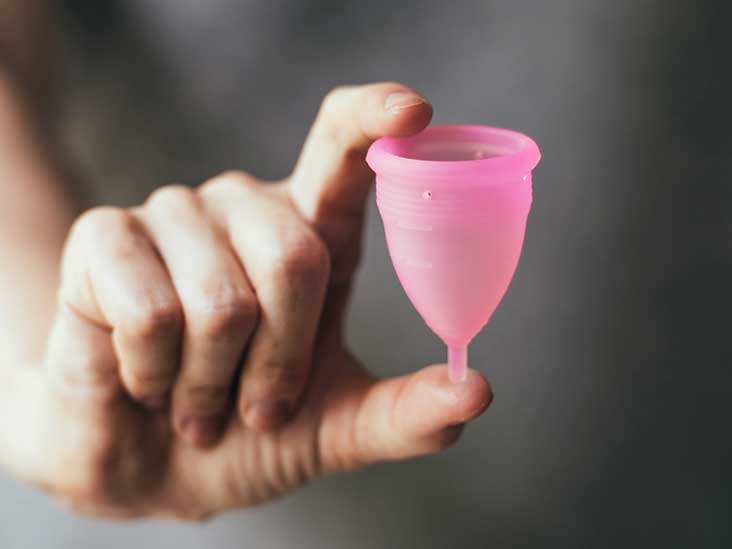
There are three occasions during which a menstrual cup with blood might leak; all of which can be easily avoided.
The first is common amongst new users who aren’t yet familiar with the fact that the vaginal canal and cervix tends to shift in direction at different times of the day. Diagrams often depict the canal as heading straight up, with no twists and turns, but sometimes you’ll find it veering naturally to the right or left, usually depending on whether your bowel is full or not.
In this instance, one might insert the cup as they have been instructed to, but not manage to get it deep enough due to an unknown veering of the canal. Instead of working to twist the cup in the necessary direction, they assume they’ve got it in just fine and go about their day. The cup is not sealed to the walls, and is likely to leak and even turn itself upside down entirely as you move about.
The second common issue is that someone has simply purchased a too small menstrual cup size, and the device is loose in the vaginal canal, allowing blood to seep around it and exit the vagina as leakage.
The third instance when leaking is possible is if a user neglects to empty out their cup and allows it to overflow. Some individuals wear their menstrual cup overnight having only emptied it out previously that morning. This puts the cup at 24 hours or more of collection time, and it is simply not designed to hold so much liquid. Naturally, the overflowing blood will lubricate around the cup rim, and work its way out of the vagina. Leaking also occur with someone who experiences very heavy periods and needs to empty their cup multiple times per day. Someone with a heavier flow may consider using a menstrual cup along with period panties if you require leak protection.
Menstrual Cup Constipation
In the aforementioned paragraph we mentioned that one’s bowel capacity can have an effect on the cervix. Many people report that wearing a menstrual cup gives them the feeling of being constipated. This is not because of actual lazy bowel syndrome occurring in the intestine, but actually just the cup fighting for space in the cervical region.
It gives the illusion of constipation: as though the bowels can now not move waste through to the anus because there is no room. This can make pooping uncomfortable, or feel like a great effort. You may even feel the menstrual cup slowly trying to push its way out of the canal.
This is not unique to menstrual cups; tampons have the same effect on the bowel region.
Long-term users of menstrual cups will be the first to tell you that all you need to do to correct this sensation of constipation is to remove your cup before pooping, and reinsert it when you are done. Removing the cup releases the cervix, and allows it to bend around the full bowels instead of pushing against them. A release of pressure is imminent, and you’ll be glad you didn’t waste a tampon in the process.
Do Menstrual Cups Make You Loose?
Some people worry that using a menstrual cup will have a stretching or loosening effect on the hymen, rendering them “less tight” down there. Some view being tight as more sexually desirable, and are averse to any objects that may put their current vaginal state at risk of changing.
We’ll gladly be the first to assure you that your menstrual cup will have no effect at all on the size or tightness of your hymen. The vagina is extraordinary and acts similarly to a rubber band, and snaps right back to its original state the minute the obstruction is removed.
If you aren’t easily convinced, take a read through the thousands of menstrual cup reviews available across the internet; not one person has reported their hymen being affected in the process of use.
Can Menstrual Cups Cause TSS?
Toxic Shock Syndrome, or TSS, is a rare yet life-threatening condition whereby toxins are released due to build up of harmful bacteria somewhere in the body.
There have been many cases worldwide where people have passed away due to TSS as a result of wearing a tampon. TSS starts off with flu-like symptoms, and quickly escalates into hypotensive shock which can stop the heart and lungs.
There would be a lot more menstrual cup horror stories to read about if they caused TSS. Because menstrual cups collect blood, as opposed to absorb it, there is a very low risk of Toxic Shock Syndrome; far lower than that of a tampon.
A gynecologist opinion on menstrual cups and TSS is that one should simply adhere to the stipulated emptying guidelines that work best with your personal flow.
Menstrual Cup Infection
There aren’t many menstrual cup dangers, but one concern whenever something is inserted into the vagina is the possibility of infection.
Common vaginal infection involves imbalance in the pH of the individual in question. The thing is, pH is rarely affected by the object itself, and rather by bacteria that was on the hands of the person doing the inserting.
It’s imperative to wash your hands properly before inserting a menstrual cup. Whatever bacteria is lingering on your fingers, or under your fingernails, is going to be transferred into the vagina and put you at risk for imbalanced pH.
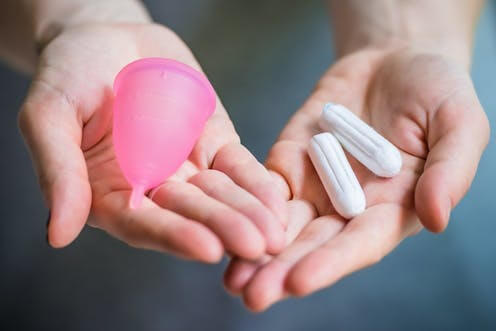
How to Use Menstrual Cup
How to Insert a Menstrual Cup
Inserting a menstrual cup takes practice, but it’s a simple recipe to follow once you know the steps. Some people find it easier to insert a menstrual cup whilst sitting down, while others aren’t able to do it unless they are standing. Some need to put a leg up on the toilet or sink, just for that extra leverage in opening up the vaginal canal.
Find whatever works for you, and don’t be scared to play around to figure it out. No one gets it right their first time! Follow this step-by-step guide on how to use a menstrual cup:
- Relax your uterus in a sitting or standing position. This step is very important. We’d also recommend emptying your bladder before inserting the cup.
- Bring the rim of the cup into the center, so that the two sides meet. Then, fold the cup into the shape of a ‘C’, so that it is a quarter of the size it usually is when fully open.
- Grip the cup from the bottom with two fingers firmly.
- Insert the cup inside of yourself, and release it as you pull your fingers out of the way. The cup will unfold immediately and settle itself into the vaginal walls. Usually, one will hear a ‘pop’ sound when the cup has formed the airtight seal, but some people may only hear this a few minutes later when they start to move through their day as usual. You may also twist the cup in place by holding to the stem in order to allow it to fully open.
How Far to Insert Menstrual Cup
All menstrual cups have a small stem-like piece at their base that is used to pull the cup out when it comes time to empty out the blood. This piece can be used to manage the depth of your cup, and should, at a minimum, be no lower than 1cm from the opening of your vagina.
Generally, menstrual cups sit a lot lower in the vaginal canal compared to tampons. They should ideally not go over the opening of the cervix, but this is sometimes not up for the user to decide; some vaginas just pull menstrual cups higher than others.
Menstrual Cup Removal
To remove your menstrual cup, you’ll likely have to adopt the same position you did when you inserted it. Sometimes, the cup will have moved upward and it may feel like an impossible task to get it out. This is never the case, and all menstrual cups will shift downward and become within reach if you sit or crouch down.
A great place to remove your menstrual cup is in the shower, as you can crouch, empty and rinse your cup all at once.
Find the stem of the cup, grip it with two fingers (using your nails helps a lot), and pull down. Just as the rim of the cup is about to exit the vagina, use more fingers to form a better grip over the cup so that it doesn’t accidentally spill on exit.
“One of the hardest things to get used to with a menstrual cup is taking it out. You need to squeeze the sides a little and bear down when removing it to break the vacuum seal. If you don’t break the vacuum, you may find that you can’t remove the cup easily,” says Christine Wilcox from This is Adult Life.
How to Clean a Menstrual Cup
People tend to know their bodies, and can make the best decisions for themselves in terms of cleaning and sanitizing.
There are some brands making specific soaps for the purpose of cleaning menstrual cups. These are great, but not absolutely necessary.
Your menstrual cup needs a proper clean and disinfection twice a cycle: just before, and just after your period. You do this by submerging the cup in boiling water for a minimum of 10 minutes, so that all accumulated bacteria can be properly destroyed.
During the week of your cycle, you will be removing and inserting your cup roughly twice a day. When you do, the cup needs a generous rinse after being emptied of the accumulated blood. After this, it can be reinserted.
The most important thing to keep clean during your cycle are your hands. Wash them thoroughly every time you go to reinsert your cup, especially if you have just used them to wash out the cup in question!
Sleeping with Menstrual Cup
Sleeping with a menstrual cup is like sleeping with any other feminine hygiene device. Do a final empty and rinse just before bed, or during your nightly shower, and the cup will work through the night regardless of what position you like to sleep in.
When you wake up, you can empty out the contents and prepare it for a new day of use. Menstrual cups result in fewer leaks during slumber, especially for people who are used to waking up in a bloody mess that seems out of their control.
Menstrual Cup Quiz
Doing a menstrual cup comparison as a beginner can be a daunting task. The best menstrual cup for your best friend may not yield the same results for you, so we encourage all newcomers to take a menstrual cup quiz in order to simplify the process of choosing the right device.
The ‘Put a Cup In It quiz’ is one that made headlines a few years ago, offering nine simple questions to guide people to finding the ‘best menstrual cup for me’. We encourage our readers to take the free, online test and gain some perspective as to what cup specifications to look out for when it comes time to purchase.
After identifying your most ideal size, you can then use the Put a Cup In It comparison chart to compare all of the existing brands of menstrual cups and their respective sizes. They even include thumbnail imagery of each cup. This makes the market much easier to navigate.
Disposable Menstrual Cups
This phrase has been tossed around a lot by consumers who don’t know enough about the market. Menstrual cups are disposable, but only after 10 years of use!
More importantly, menstrual cups don’t ever need to be disposed of as they are fully recyclable when it comes time to end their life span.
The real disposable menstrual cups are actually tampons and pads, and they’re polluting our planet at an alarming rate. We understand that not all people are necessarily able to insert objects into their vaginas; there are those who find it too unnatural and even painful. They feel they have no choice but to use pads; however, we’d encourage all with this belief to do some research into what are now known as period panties, as well as reusable pads that can be washed instead of disposed of.
Best Menstrual Cups
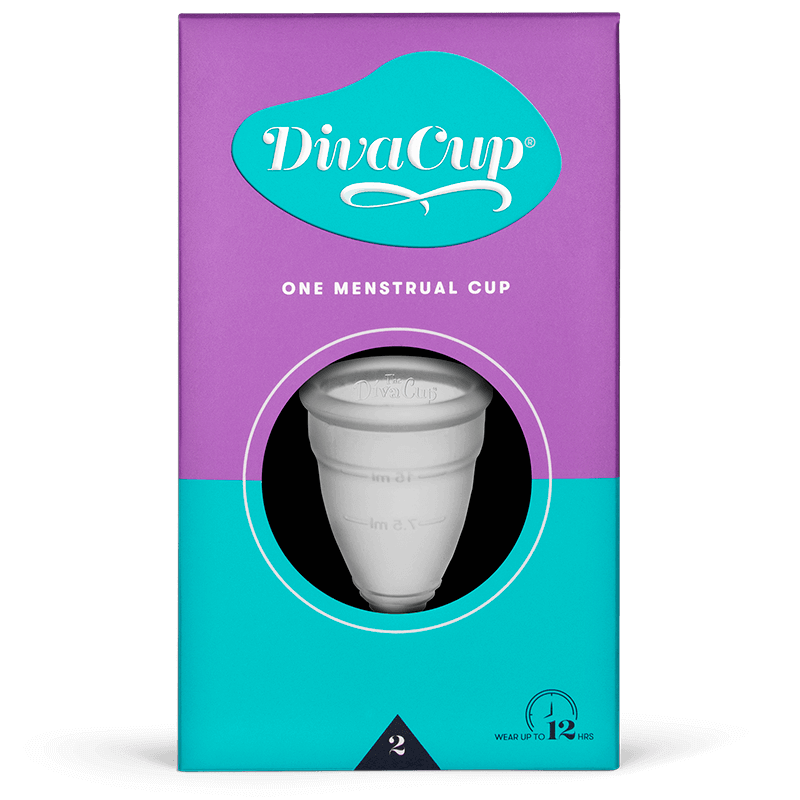
Diva Cup
What is a Diva Cup?
The Diva cup was the first major brand of menstrual cups offered for public consumption within the feminine hygiene market. They pioneered the movement, and brought this self-care alternative to the world just as tampon/pad waste was reaching an all time high.
Diva Cup makes some of the best menstrual cups. Their range is diverse, and they pride themselves on their 12 hour protection rate. You can wear a Diva Cup when attempting any physical activity, excluding intercourse (obviously).
Diva Cup Sizes
There are three Diva cup size options to choose from. They are Model 0, Model 1 and Model 2.
While they classify their sizes by age brackets, this is a very general approach to menstruation as age doesn’t necessarily determine vaginal size or flow. Their Model 0 is intended for individuals 19 years or younger, their Model 1 for individuals between 19 and 30 with medium flow, and their Model 2 for individuals 30 years or older, or those with extremely heavy flow.
They also offer a plant based cleansing solution that can be used to properly care for your device after purchasing.
Diva Cup Diagram
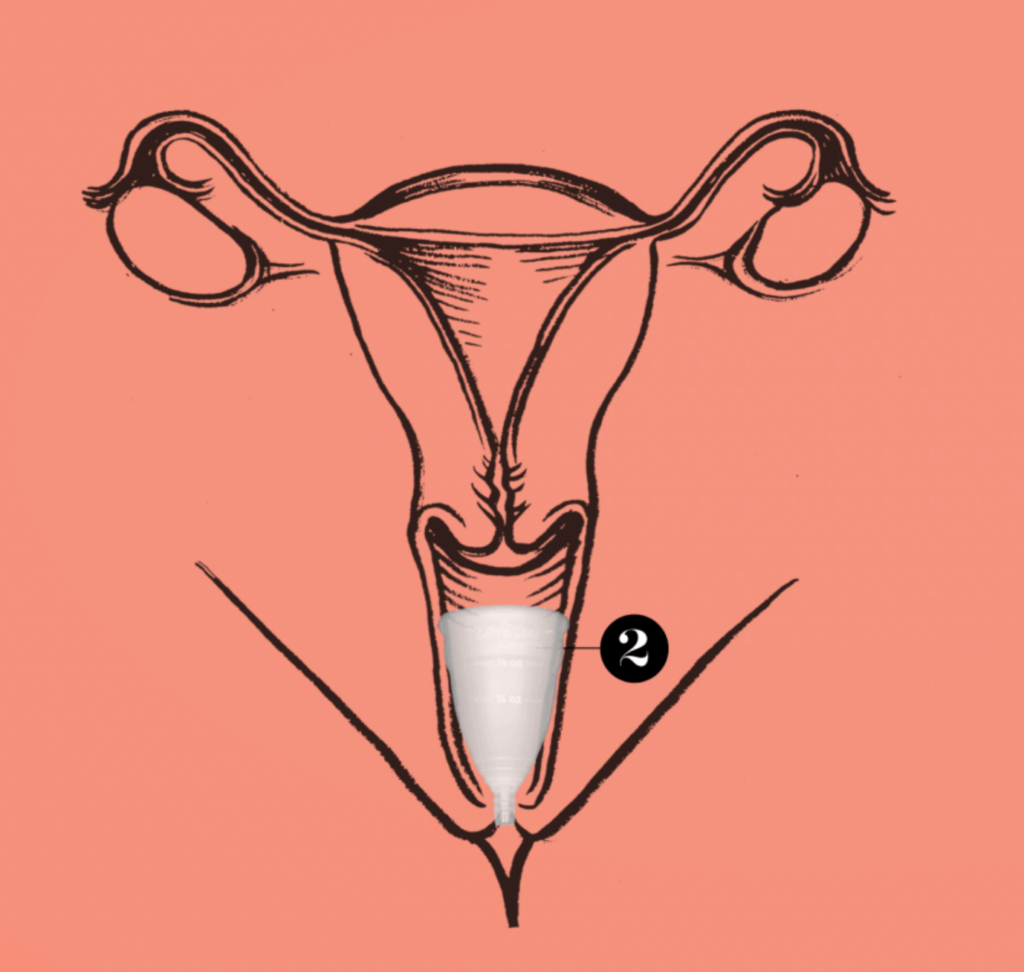
You can use the following diagram to better answer the question: how does a diva cup work? Everyone’s cervix is different, and reaches different heights. For the most part, the standard Diva cup will sit well below the cervix like so:
Diva Cup Instructions
Wondering how to use a Diva Cup? The process is no different to any other menstrual cup on the market.
Diva cups are made from a quality soft silicone that actually gets more flexible as it attunes to the natural heat of the body. The silicone rim and cup body are easy to fold and maneuver into the vagina, as directed.
There are four holes in the rim of each Diva cup that work to seal the cup into place, reducing the risk of leakage quite significantly. The stem comes in a standard length across all models, but it can be trimmed to suit one’s personal needs in terms of comfort. Just make sure you don’t cut it too short that your nails are no longer able to grip it at the time of pulling out.
You may also want to know how to rotate the Diva cup if it’s sitting at an uncomfortable angle. To do this, you’ll need to break the existing seal by reaching in with one finger, and sliding it up the side of the cup until you break the surface. This will cause the seal to give in, and you’ll be able to rotate it without much trouble.
Smallest Menstrual Cup
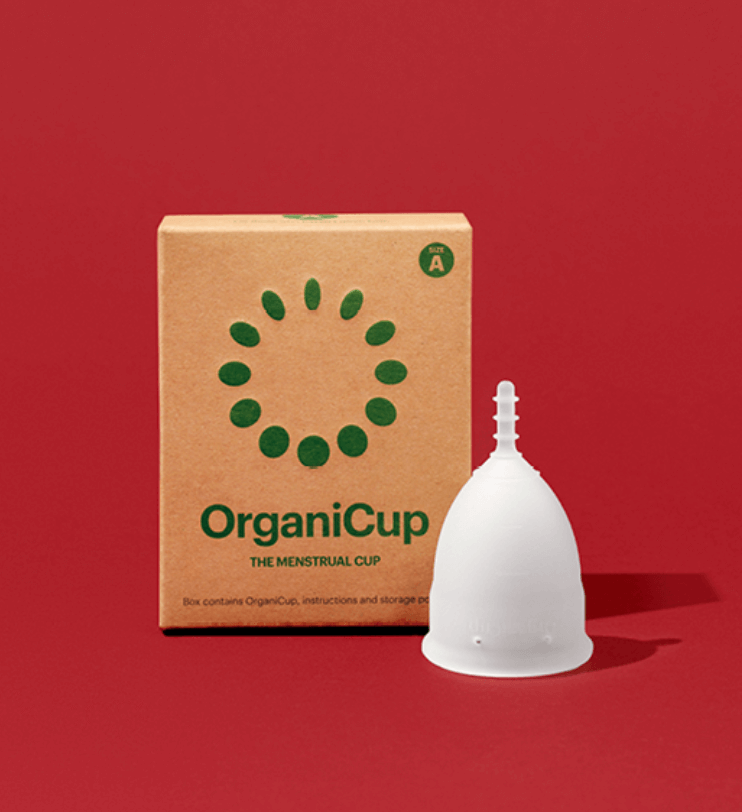
OrganiCup Menstrual Cup
A product that has been making waves across worldwide media publications is the OrganiCup. This is an environmentally friendly (greener) rendition of the regular menstrual cup that is 100% vegan friendly, and non-allergenic.
Their range offers three competitive cup sizes: mini, size A and size B.
OrganiCup have distinguished their different cups based on the experience of giving birth. Their mini cup is for teens and anyone who is generally just smaller down there, and is one of the smallest cups you’ll find on the market. Their cup A is for anyone who has not birthed a child, and their cup B is for those who have.
Best Menstrual Cup for Low Cervix
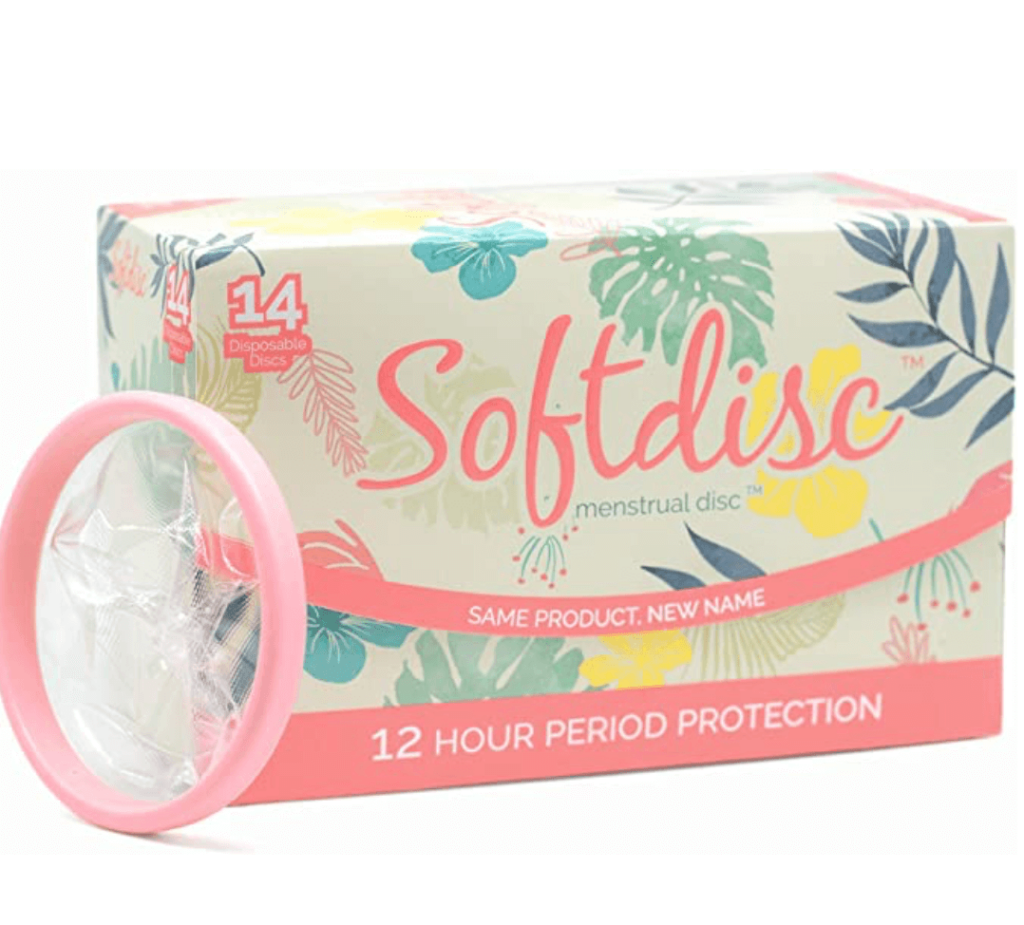
Softcup Menstrual Cup
When scouring menstrual cups on Amazon, Softcup is a name that will come up time and time again. These, however, are not actually menstrual cups at all, but a rather new technology called menstrual disks.
They look a lot like glorified condoms, only they don’t have much depth and are much, much wider. These disks are inserted into the vagina in the same way you would a regular menstrual cup, and they sit within the walls catching the blood.
They offer the same 12 hour protection window, but they can’t be reused after use. These are disposable products and you’ll need to repurchase a new batch once a month.
These disks are phenomenal for anyone with a particularly low cervix as they have little to no depth to them at all.
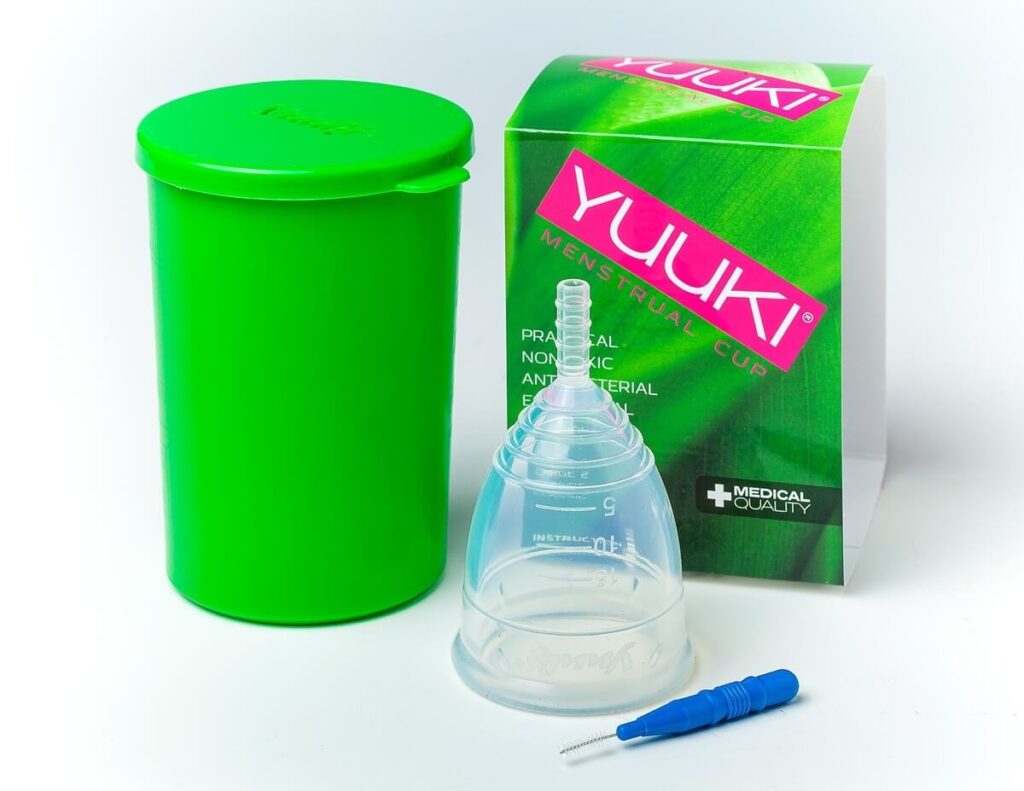
Yuuki Cup
The Yukki cup is a brand we’ve been keeping an eye on for a while. They are one of the first to use medical grade Czech silicone that has a lifespan of up to 15 years, if properly taken care of. It’s rare for menstrual cup brands to offer anything higher than the standard 10 years.
The cups are also colorful and unique, shying away from the usual translucent devices we’ve become used to. We love that each purchase comes with a cup holder that seals shut, so you have somewhere to store your device in the weeks when it is not in use.
The Yukki cup is one of the more affordable menstrual cup brands. It’s a great entry-level product for those wanting to dip their toe into the world of reusable hygiene products.
Best Menstrual Cup for High Cervix
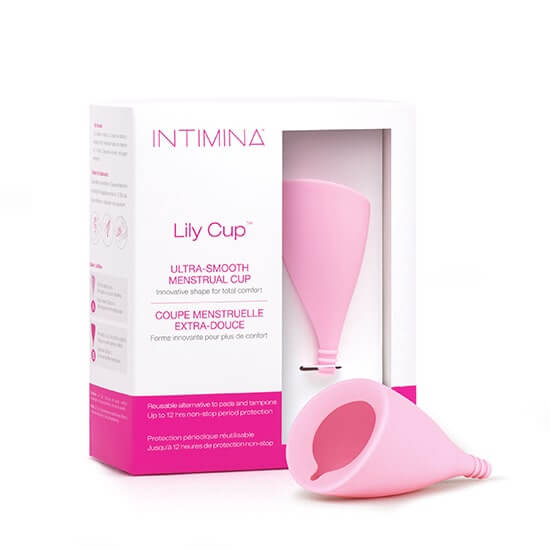
Lily Cup
The Lily Cup is a menstrual device made by feminine hygiene brand Intimina. It’s one of the most uniquely shaped cups on the market, featuring a very alternative design.
There is no rim to the Lily Cup; instead the device has a slanted ridge that feeds into the holding area. The cup is thinner than a tampon, but can hold its contents for up to 12 hours.
This is the best cup for those who have a higher cervix, or heavier flow. You can choose between two size variations.
Best Menstrual Cup for Sensitive Bladder

Saalt Cup
Saalt’s intention was to simplify the experience of a period, which can be a whirlwind at the best of times. They designed a range of incredibly soft silicone cups, designed to be more comfortable for individuals who suffer from bladder sensitivity and IBS.
Firmer cups can aggravate these conditions, but Saalt blends in, doesn’t irritate, and leaves no trace of itself behind in the days after the end of your period when yeast infections like to pop up unannounced.
We personally love their black-toned unit, but if you don’t, there’s pink, green, blue… the works!
Best Menstrual Cup for Heavy Flow

Venus Menstrual Cup
A heavy flow can be a difficult thing to navigate when shopping for menstrual cups, because a heavy period is not necessary heavy throughout the entire cycle. The first two to four days may be particularly intense, and then, as the cycle starts to ease up, the flow becomes much lighter.
Venus Cups have catered to this exact need by offering a starter kit of two different sized cups, for the same price as a single cup would usually cost. You’ll be able to use the two variations at different points in your cycle, opting for the larger when things are heavy, and the smaller when things are light.
This is definitely the best solution for heavy flow that we’ve been able to find.
Conclusion
In conclusion, we’d encourage all of our readers to seriously consider making the switch from tampons to menstrual cups if their situation allows for it. There is great benefit to be offered to your body, as well as the environment.
In 2018 alone, an estimated 570,000 people were diagnosed with cervical cancer worldwide, and of them roughly 311,000 lost their lives as a result. Any measures we can take, collectively, to bring these numbers down is a step in the right direction.
Menstrual cups are a safer, greener and more economical solution to feminine hygiene. The initial investment is paid off within the first four months, leaving 116 months to go before you even have to think about a reinvestment.
We’d recommend all new buyers to start soft and small, when in doubt. You can always move up to a bigger sized cup at a later stage, or a cup made from a slightly firmer material.
And as Alila Rose Grace from Mahina Cup so succinctly puts it, “Every woman deserves to period in confidence, hygiene and dignity.”
Did You Enjoy This Article?
If you enjoyed this article, you might also like our other articles such as Period Panties, Natural Hair Removal, Gold Face Mask and Eye Mask, and Facial Steamer.

